Tips for Watering Your Lawn in Minnesota
Why is watering your lawn important? Most living things require water to thrive, and your grass is no exception. Proper lawn watering keeps your lawn looking lush, promotes a healthy root system, and even helps reduce the number of weeds in your lawn. With the few essential lawn watering tips compiled by our experts, you can keep your lawn watered well and avoid pitfalls from over or under-doing it. We also included tips for keeping your lawn alive under drought conditions.
What are the benefits of proper lawn watering?
- Encourages deeper root growth, making the grass more resilient against damage from pests, disease, and drought
- Supports a thick lawn that crowds weeds out by making it difficult for them to germinate
- Promotes efficient water use by reducing the amount of water lost through evaporation, and watering at times or in areas it is not needed
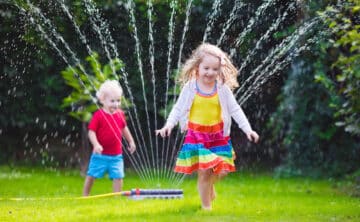
Ten quick facts for watering your Minnesota lawn
- Grass needs about 1” to 1 ½“ of water per week, depending on weather and location.
- Dry grass will have a blue-gray hue, and the blades will wilt and won’t bounce back when stepped on.
- Plan to water when temperatures reach 85 degrees, or there is a dry spell.
- Water deeply and infrequently.
- Overwatering leads to shallow root systems and can drown new grass shoots.
- Water in the early morning to avoid evaporation or leaving grass too wet, inviting disease.
- It’s okay to let your lawn start to go brown since it will recover quickly once watered.
- Water as needed: shady areas will need less frequent watering than sunny spots.
- Clay soil will not drain as quickly as sandy types.
- Newly planted lawns have additional watering requirements to ensure healthy root development.
How often should I water my lawn?
The simple answer is to only water your lawn when it needs it. But we all know determining that is easier said than done! As much as possible, tailor your watering routine to fit the needs of each area of your lawn. Sunny spots will need to be watered more often than shaded areas. An automated sprinkler system that is not adjusted to water areas according to their needs, or the weather conditions can waste water, and leave grass vulnerable to disease and damage–especially if there are areas of standing water.
When should I start watering my lawn in Minnesota?
Depending on seasonal weather conditions, including the amount and timing of snowmelt, you can usually wait until late spring or early summer to begin watering. Avoid watering too soon, as this may stunt root growth and invite fungal disease.
How much water does my lawn need?
In general, lawns need approximately 1” to 1½” of water per week, including rainfall. Our experts recommend watering grass less often and more deeply. Giving your lawn a good soaking and allowing time between waterings encourages roots to grow deeper as they seek out moisture. A robust root system allows your grass to stay greener longer, and it will require less water over time. Remember that newly established lawns from seeding, hydroseeding, or sod require more water.
Lawn watering tips for new seed, sod, or hydroseeding
- Water often: 2 to 4 times per day, depending on the weather.
- Water at least two times per day when temperatures exceed 85 degrees.
- Water in the middle of the day for new growth, as this is the most stressful time of day for seedlings.
- It’s nearly impossible to overwater new seeding or sod!
How long should my sprinklers run?
Many factors determine how much water each area of your lawn needs and how much water your sprinkler system provides per minute. As a general rule of thumb, sprinklers running approximately 30 minutes twice a week will provide about 1” of water per week.
How can I tell the difference between a dry lawn and a lawn that has gone dormant due to drought?
The first sign that a lawn is dry is wilting grass that lays flat and does not bounce back when stepped on. If the lawn continues to be dry, it will turn brown and go dormant as the plant tries to preserve itself and conserve water. The soil will also become much harder.
How can I protect a dormant lawn?
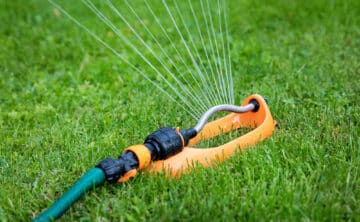
Across the Minneapolis and St. Paul metro, we experienced drought conditions in 2021 and 2022. There are times when the weather and the local water supply are simply beyond your control. If environmental concerns, high water costs, or water restrictions prevent you from watering your lawn as often as you’d like, there are simple steps you can take to save it.
- If possible, maintain a minimal watering schedule of ½” of water every 7-14 days. Your lawn will still look brown, but will have a better chance of surviving the drought.
- A dormant, drought-stressed lawn can be easily damaged, so it is best to stay off it as much as you can.
- Once the lawn begins to receive water again, it should start to green up within 14 days; some areas may need to be reseeded.
What happens if my lawn gets too much water?
Too much water can damage your lawn or even your home’s foundation. Grass cannot grow properly in areas with standing water or spongy soil, which allows moss to develop. You may choose to re-grade your yard, amend heavy clay soil with organic matter to improve drainage or install a rain garden or mulch bed in low spots that frequently fill with standing water.
How can I fix problems with my lawn being too wet?
Thatch build-up and soil compaction are two common problems that prevent soil from draining well. Thatch can be removed with a rake or a power dethatcher. Core aeration can improve soil drainage and allow the root system to receive nutrients more efficiently.
Conserve when you can!
Both for the health of your lawn, and your water bill, we’ve got some tips on how to conserve water when watering your lawn. Keep automatic sprinkler systems maintained and properly set. A broken sprinkler head that shoots a stream of water into the street doesn’t do anyone any good, nor does one that runs during a rainstorm. Additionally, trees can be damaged from lawn watering that leaves their trunks wet over time, or does not allow their roots to stretch out and grow between waterings.
Environmentally Friendly Lawn Watering Tips
- Mow to a height of 2-3 inches, leaving taller grass blades to shade the soil and limit evaporation.
- Set an alarm to avoid forgetting that sprinklers are running.
- Use a sprinkler head that sprays larger droplets to avoid losing water through evaporation or wind.
- Consider seeding your lawn with drought-tolerant fescues.
- Maintain a minimal watering schedule of ½” of water every 7-14 days, as restoring a dead lawn will have a higher environmental impact than minimal watering.
Want a lawn that stands up to finicky rainfall?
Rainbow has custom-blended seeding solutions to meet your goals and the conditions in your yard. Our drought-tolerant seeding solution is a tall fescue type that produces a great-looking lawn that resists damage from dry spells.
If you have extensive damage due to drought, schedule a consultation with one of our lawn experts today!
Other items you may be interested in:
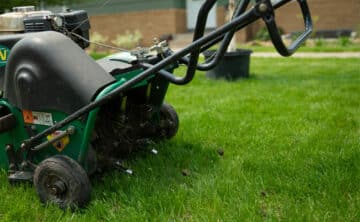
Lawn Aeration
If you notice thin, bare patches, your lawn can benefit from our lawn aeration service.
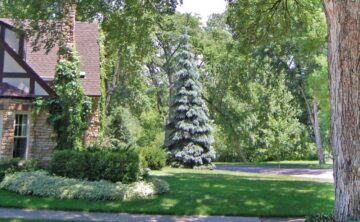
Why We Love Our Lawns: A Brief History Of American Lawn Care
America’s love affair with our lawns is as passionate as ever. However, some things have changed—including our image of the ideal lawn. One person’s dream
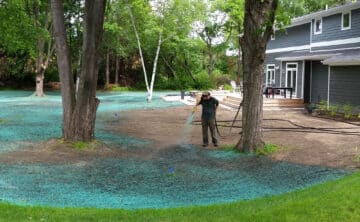
Hydroseeding
Our hydroseeding service combines seed, fertilizer, hydro-mulch, and water in a customized blend for your lawn.



